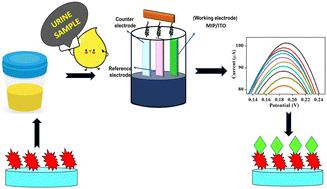当前位置:
X-MOL 学术
›
Environ. Sci.: Nano
›
论文详情
Our official English website, www.x-mol.net, welcomes your feedback! (Note: you will need to create a separate account there.)
A molecularly imprinted polymer based on a novel polyaniline–zinc sulfide nanocomposite for electrochemical detection of trimethylamine N-oxide
Environmental Science: Nano ( IF 7.3 ) Pub Date : 2022-09-08 , DOI: 10.1039/d2en00624c Damini Verma 1 , Reena K. Sajwan 1 , G. B. V. S. Lakshmi 1 , Anil Kumar 2 , Pratima R. Solanki 1
Environmental Science: Nano ( IF 7.3 ) Pub Date : 2022-09-08 , DOI: 10.1039/d2en00624c Damini Verma 1 , Reena K. Sajwan 1 , G. B. V. S. Lakshmi 1 , Anil Kumar 2 , Pratima R. Solanki 1
Affiliation

|
The generation of gut microbiota-derived trimethylamine N-oxide (TMAO) from the metabolism of dietary L-carnitine and choline is associated with a high risk of major adverse effects on humans. For this purpose, cheap, rapid, highly sensitive, and accurate electrochemical sensors are needed to detect TMAO in real samples clinically. Thus, a sensor showing all these features is developed based on a molecularly imprinted technique and characterized using X-ray diffraction, scanning electron microscopy, UV-Visible spectroscopy, and Fourier transform infrared spectroscopy in this study. The MIP sensor is fabricated using a novel nanocomposite (PANI–ZnSNPs) that comprises a polyaniline polymer (PANI) and zinc sulphide nanoparticles (ZnSNPs) that serve as a receptor and are deposited on an indium tin oxide (ITO) coated glass substrate using the electrophoretic deposition technique. The chemical interaction responsible for bonding between the gut metabolite TMAO and PANI–ZnSNPs is hydrogen bonding occurring between the oxygen atoms of N-oxides and NH of PANI on the addition of TMAO concentrations resulting in a decrement in the current (after 10 min of incubation time) and electro-activity of the sensor. The developed MIP sensor exhibited a linear range from 5 μM to 180 μM having a limit of detection of 4.35 μM. Moreover, the sensor showed a high sensitivity of 0.276 μA μM−1 cm−2 (R2 = 0.984), as well as relative standard deviation (RSD) values for selectivity analysis, which were found to be in the range of 3.12% to 7.50% for several interfering agents. It also showed promising results related to reproducibility (RSD = 4.34%), repeatability (RSD = 0.08%), and the potential to determine TMAO in spiked urine samples with acceptable RSD, as well as % recovery values ranging from 96.67–110.58% and 0.55–7.11%, respectively. The current strategy is potent and opens a new pathway for developing fast diagnostic tools for TMAO detection and other metabolites.
中文翻译:

基于新型聚苯胺-硫化锌纳米复合材料的分子印迹聚合物用于电化学检测三甲胺 N-氧化物
从膳食L的代谢中产生肠道微生物群衍生的三甲胺N-氧化物 (TMAO)-肉碱和胆碱与对人类产生重大不利影响的高风险有关。为此,临床上需要廉价、快速、高灵敏度和准确的电化学传感器来检测真实样品中的 TMAO。因此,基于分子印迹技术开发了一种显示所有这些特征的传感器,并在本研究中使用 X 射线衍射、扫描电子显微镜、紫外-可见光谱和傅里叶变换红外光谱对其进行了表征。MIP 传感器是使用一种新型纳米复合材料 (PANI-ZnSNPs) 制造的,该复合材料包含聚苯胺聚合物 (PANI) 和硫化锌纳米粒子 (ZnSNPs),它们用作受体并使用电泳沉积技术。加入 TMAO 浓度时 PANI 的N-氧化物和 NH会导致电流(孵育 10 分钟后)和传感器的电活性降低。开发的 MIP 传感器表现出从 5 μM 到 180 μM 的线性范围,检测限为 4.35 μM。此外,该传感器显示出0.276 μA μM -1 cm -2 ( R 2= 0.984),以及选择性分析的相对标准偏差 (RSD) 值,发现几种干扰剂的范围为 3.12% 至 7.50%。它还显示了与重现性 (RSD = 4.34%)、重复性 (RSD = 0.08%) 相关的可喜结果,以及在具有可接受的 RSD 的加标尿液样品中测定 TMAO 的潜力,以及 96.67-110.58% 和范围内的回收率百分比值和分别为 0.55–7.11%。目前的策略是有效的,并为开发用于 TMAO 检测和其他代谢物的快速诊断工具开辟了一条新途径。
更新日期:2022-09-08
中文翻译:

基于新型聚苯胺-硫化锌纳米复合材料的分子印迹聚合物用于电化学检测三甲胺 N-氧化物
从膳食L的代谢中产生肠道微生物群衍生的三甲胺N-氧化物 (TMAO)-肉碱和胆碱与对人类产生重大不利影响的高风险有关。为此,临床上需要廉价、快速、高灵敏度和准确的电化学传感器来检测真实样品中的 TMAO。因此,基于分子印迹技术开发了一种显示所有这些特征的传感器,并在本研究中使用 X 射线衍射、扫描电子显微镜、紫外-可见光谱和傅里叶变换红外光谱对其进行了表征。MIP 传感器是使用一种新型纳米复合材料 (PANI-ZnSNPs) 制造的,该复合材料包含聚苯胺聚合物 (PANI) 和硫化锌纳米粒子 (ZnSNPs),它们用作受体并使用电泳沉积技术。加入 TMAO 浓度时 PANI 的N-氧化物和 NH会导致电流(孵育 10 分钟后)和传感器的电活性降低。开发的 MIP 传感器表现出从 5 μM 到 180 μM 的线性范围,检测限为 4.35 μM。此外,该传感器显示出0.276 μA μM -1 cm -2 ( R 2= 0.984),以及选择性分析的相对标准偏差 (RSD) 值,发现几种干扰剂的范围为 3.12% 至 7.50%。它还显示了与重现性 (RSD = 4.34%)、重复性 (RSD = 0.08%) 相关的可喜结果,以及在具有可接受的 RSD 的加标尿液样品中测定 TMAO 的潜力,以及 96.67-110.58% 和范围内的回收率百分比值和分别为 0.55–7.11%。目前的策略是有效的,并为开发用于 TMAO 检测和其他代谢物的快速诊断工具开辟了一条新途径。



























 京公网安备 11010802027423号
京公网安备 11010802027423号